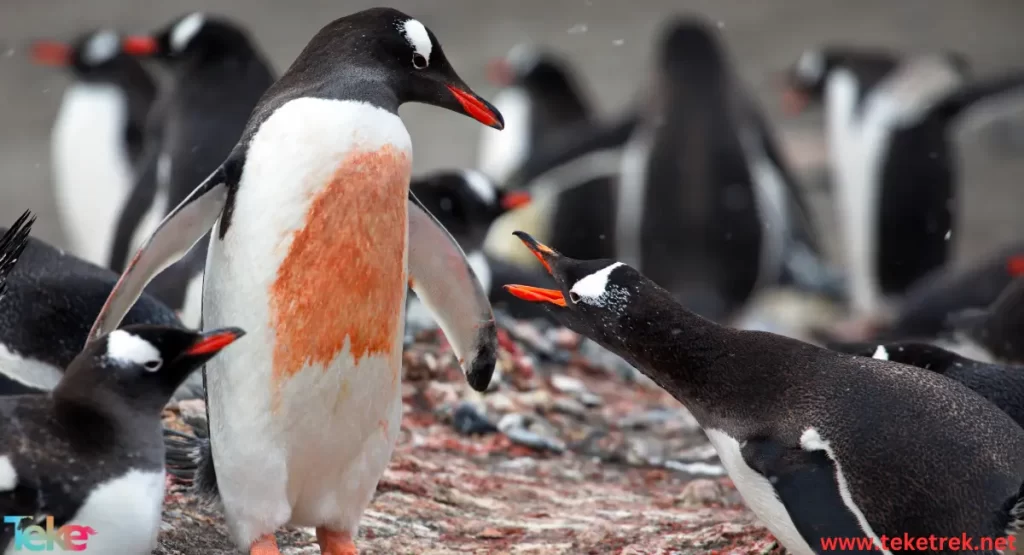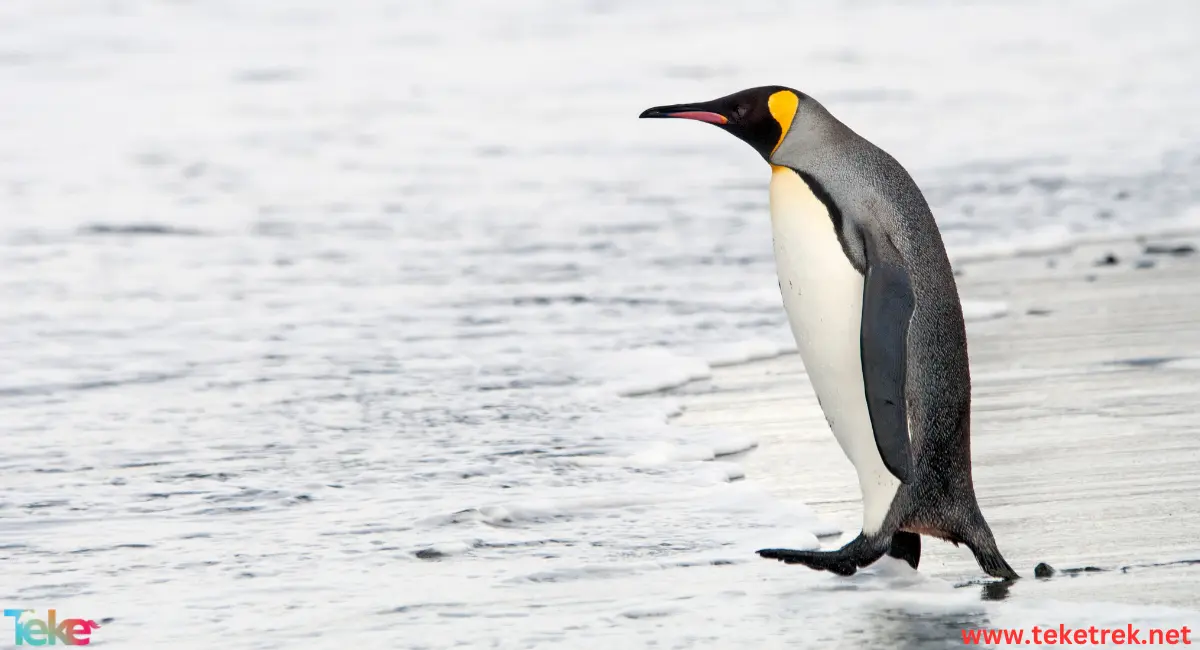The penguin bird is a unique seabird belonging to the seabird mily. It is a flightless bird and inhabits the Antarctic regions and the southern oceans. These creatures are distinguished by distinctive personalities and remarkable social behavior, and the penguin is considered a member of the Spheniscidae family. Below on the teketrek website we talk more about them.
Penguin bird specifications
The penguin bird is vertebrate animal, it have a round and short body, which enables them to swim quickly and efficiently in the water.
- They have thick, short, waterproof feathers that allow them to float easily and retain their heat in cold environments.
- Penguins are distinguished by their vibrant colors such as white, black, and gray, with various patterns that help them camouflage in the water and protect themselves from natural predators.
- The penguin’s head is relatively small with a pointed beak that aids in catching fish while swimming.
- Penguins have short, strong legs equipped with feathered extensions that help them maintain balance while walking on ice.

Penguin under water
- The penguin bird is considered a slow bird on land but is one of the best marine creatures in swimming. It has flippers that aid in swimming, and it can swim for up to 10 hours at a speed of 13 kilometers per hour. Penguins leap out of the water to breathe every minute. They possess remarkable skills for fishing and can stay in the water for extended periods without the need to come out.
- The Gentoo penguin is the fastest underwater bird globally, reaching speeds of up to 36 kilometers per hour while searching for food or escaping predators. They can also dive to depths ranging from 170 to 200 meters.
- Smaller penguins usually do not dive deeply, while larger penguins can dive to greater depths if necessary. Emperor penguins are the most profound divers among birds, capable of diving to depths of about 550 meters while searching for food.
- Penguins can walk at a human’s pace and can climb rocky slopes, jumping from one rock to another with ease. Some penguins have the ability to slide on snow or ice by suddenly descending sharply and sliding on their bellies.
Penguin life
- Penguins have a remarkable ability to adapt to harsh environmental conditions, whether extreme cold or challenging marine life conditions. They possess a thick layer of fat under the skin for insulation and to maintain body heat in polar waters. This layer is covered by down feathers, topped with outer feathers, providing warmth. Some glands in the penguin’s body release oil that covers its feathers, making its body resistant to water and wind.
- Penguins exhibit strong social lives, living in large colonies comprising thousands of individuals. They rely on these groups for protection and the rearing of their offspring.
- Penguins inhabit polar continents such as Antarctica and the Antarctic Peninsula, as well as wild coastlines in other regions like New Zealand and Australia.
Penguin locations
- Penguins inhabit various regions around the world, and there are numerous different species ranging between 17 and 20 types. Here are some well-known species and their locations
Species of Penguin
1. Emperor Penguin:
– Found in Antarctica and the Southern Polar Regions. The Emperor penguin is considered the largest species, with a length of 1.1 meters and a weight of 35 kilograms or more. It is characterized by its black and white coloration.
2. King Penguin:
– Located in the Falkland Islands, South Atlantic Islands, and Australia. The King penguin is distinguished by its large size and brightly colored orange plumage.
3. Yellow-eyed Penguin:
– Also known as “Hoiho” or “Tarakaka,” this species is exclusive to New Zealand.
4. Adélie Penguin:
– Found in South Africa and Australia. Recognized by its oddly shaped black beak.
5. Royal Penguin:
– Can be found on the Macquarie Island near the frozen South Pole or nearby islands.
– The average length of the Royal Penguin is 65-76 cm, and it weighs 3-8 kg. It has a white face and chin.
6. Galápagos Penguin:
– One of the few species living north of the equator. The Galápagos penguin is the smallest of penguin species, measuring around 49-53 cm and weighing about 2.5 kg. It resides in the Galápagos Islands in the Pacific Ocean, characterized by black feathers on the back and white on the abdomen.
7. Little Blue Penguin:
– Only found on Chatham Islands, as well as in the southern part of Tasmania, Australia, and New Zealand.
- It stands at a height of 30-35 cm and weighs only one kilogram. It has grayish-white color on the belly and dark blue on the chest, while the back, wings, and tail are dark blue.
- These polar environments and cold regions provide penguins with a rich food source of fish and krill, aiding them in adapting to harsh environmental conditions and the extreme cold prevalent in these areas.
The reason why penguins are called this name
- The name “penguin” is believed to have originated from the Old Welsh language, where it was thought to be “pen gwyn,” meaning “white head.” Over time, this name evolved into “penguin” in the English language. This change may be associated with the white appearance that is evident on the faces of penguins.
Penguin food
The diet of penguins primarily consists of fish, krill, and squid, with the specific type of food varying depending on the penguin species and its natural habitat. For example, some penguin species primarily feed on squid and small fish, while others rely heavily on krill as a significant part of their diet. Penguins hunt for their food in cold waters and polar oceans.
Penguin reproduction
- Penguin bird is non mammal animal, in general, involves a complex and fascinating series of events, with slight variations among different species.
- The age of sexual maturity also varies among penguin species. Penguins typically start reproducing when they reach a certain age, ranging approximately from 3 to 8 years, depending on the species.
- Most penguins lay two eggs in each nest, although larger species like the King Penguin and Emperor Penguin lay only one egg.
- The incubation period varies as well, depending on the penguin species. Generally, the incubation period for penguins ranges from approximately 1 to 2 months.
- Some penguin species build nests using pebbles and stones, where the female lays the eggs. Both parents take turns incubating the eggs and feeding the chicks.
Penguin characteristics
- Despite their active social lives within colonies, penguins often display a calm and serene demeanor, especially during large gatherings.
- Penguins exhibit a high level of organization and dedication in caring for their offspring and protecting their environment.
- Penguins interact with each other through body movements and sounds, enhancing communication and coordination within colonies.
- Penguins are characterized by remarkable social behavior, living in large groups and collaborating in hunting and caring for their young.

The effect of Bergmann’s rule on the size and distribution of penguins in the world
The impact of the Bergmann’s rule on penguins reflects how their sizes are distributed concerning geographical regions, with larger penguins tending to inhabit colder areas, unlike smaller ones that live in warmer regions.
FAQ
How do you describe a penguin?
The penguin bird is a sea bird with a fusiform body that is pointed on both sides and streamlined. It has a large head, with a short neck, and a short tail.
What kind of animal is penguin?
Penguins are adapted to live in the sea, where they spend 75% of their lives, and then move to the beach to breed.
Where do the penguins live?
Penguins live only in the Southern Hemisphere, on the coast of Antarctica and the islands below it.
Do penguins have feathers?
Yes, penguins have feathers.
Do penguins give birth or lay eggs?
Penguins reproduce by eggs.
Finally, The penguin bird face numerous threats such as climate change, habitat loss, pollution, and illegal fishing.
International efforts to conserve penguins include establishing natural reserves, enacting legislation for their protection, increasing awareness about the importance of preserving these creatures, as well as supporting scientific research and enhancing collaboration between countries for knowledge and expertise exchange in this field.





